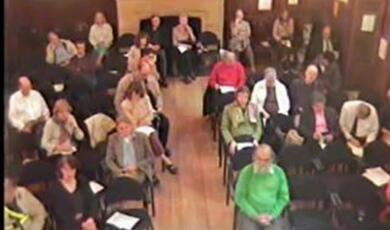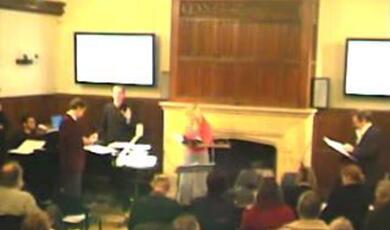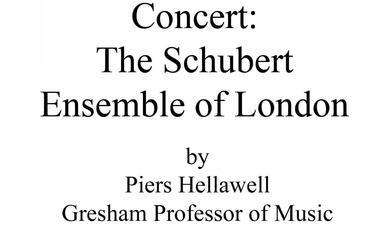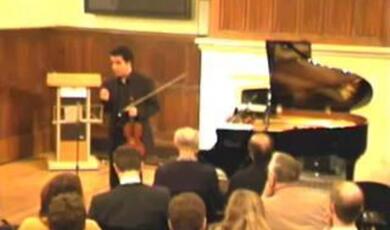Chamber Music Fights Back
Share
- Details
- Transcript
- Audio
- Downloads
- Extra Reading
When high art music struggles to compete in a market-place full of more accessible sounds, it is instrumental chamber music that feels the cold most acutely - yet great composers still turn to this medium for some of their most personal revelations. This talk covers some exciting new initiatives for young players, and explores the self-reinvention of the string quartet.
Download Transcript
Chamber Music Fights Back
Professor Piers Hellawell
Chamber music is not a body of repertoire but a statement of intention. It is not a single medium of music - say, the string quartet - much less a single historical style of music from the high Classical salon, but a certain spirit of music-making. Much of the image problem with which the genre of small instrumental ensemble music continues to grapple arises, however, from this perception - that 'chamber music' denotes a certain repertoire, played by periwigged figures who are busily ignored by lavishly costumed dancers from some BBC classic serialisation. This is wrong not because that is not chamber music - it may be - but because it allocates the concept to a specific social and historical repertoire and situation of music-making: it suggests that chamber music was a phase in music history, and therefore that contemporary efforts at this genre are somehow an exercise in nostalgic recreation, like that classic serialisation itself.
On the contrary, because chamber music is a particular spirit of performance, rather than a body of works, it exists outside the bounds of music history and national cultures. If there is a music-making that is, truly, an anachronistic exercise in nostalgia it is the orchestral concert; this presents for the most part repertoire at least 100 years old, while most more recent music finding its way onto programmes also adopts the archaic deployment of instruments that evolved between Haydn and Brahms - four horns, violins divided into 1st and 2nd, timpani - why, for goodness sake? Timpani evolved in the orchestra underlining harmonic progressions in the bass, while the dual division of violins arose from the tune-and-bass format of the 18th-century trio sonata, where a melody was shared in imitation. Neither role has much currency in music written since 1945, but every orchestra has a timpanist and divisi violins, largely because that orchestra mostly plays music by dead composers. That is an anachronism if you like, and some say increasingly an uneconomic one, despite the much-vaunted talents of new music for depressing box-office further. I for one love the orchestra dearly, and would go to the barricades to keep it going - which we may have to. Chamber music, meanwhile, is a spirit that has endlessly reinvented itself, and will continue to do so, because - unlike the orchestra - it is not tied to any genre, but to the practice of elevated cooperation - the creative spirit at its best, you might even say.
That spirit embraces at once the frothiest, most easily ignored expression -
EX Divertimento (early Haydn String Quartet – from op3)
and the most demanding in intensity.
EX 1 st String Quartet by Carter
It is at once the most extrovert celebration -
EX Royal Garden Blues (Marsalis)
and the most ruminative of laments.
.
EX Albert Collins - slow blues
You will notice that my last two musical excerpts were from Jazz and the Blues. It doesn't matter if the players are a Quartet in the Wiener Konzerthaus, a group of teenagers thrashing on guitars in a garage or a clutch of tribal musicians under a tree in the veldt; where two or three musicians are gathered together to listen to one another as they play, you've got chamber music.
The last hundred years have given chamber music, like most other musics, a fierce and invigorating shock treatment, after a period of prolonged stability. We have seen in earlier lectures how the last century saw a breakdown in consensus about the nature of art itself, with a retreat to high and inaccessible ground on the part of an elite. Among many reasons for this were the democratisation of music that followed the arrival of the recording process and the loss of the cousin-relationship between 'serious' and 'popular' western musics (1). The combination of these factors – a freshly independent and rebellious popular music and the means to disseminate it on a huge scale - meant the fragmentation of all musical audiences and of assumptions about a 'mainstream'. As my guest in a previous discussion, David Whelton, commented, 'every music today is a minority'. There is no question that the 'chamber music spirit' has been relocated somewhere in this upheaval, but is this all bad? In this redefined world, the rise of a massive commercial juggernaut behind music of simple and largely forgettable material is often portrayed, not least by me, as the enemy of high artistic ideals in music; last year we heard from the commentator Adorno that the growing mass culture was a major factor behind the more abstruse modes of expression of the avant garde. Yet the longer view may yet be that this commercial music is not just a contradiction of what music has been but also, here and there, a reaffirmation: I have no doubt, at any rate, that the true flame of chamber music, flickering low perhaps in the concert life of the mid 20th Century, was burning strongly in Blues, Rock & Roll and, perhaps most determinedly, in Jazz, which to this day refuses the offer of ideas above its station. Another medley of excerpts will make the point more succinctly. What is it that is shared by the following works?
EX Stockhausen: Stimmung
Muggsy Spanier - September in the Rain
Beach Boys – Wouldn’t It Be Nice
What unites them is the interplay between the vocal or instrumental lines, the sense not only of interplay but of mutual support that is the opposite of soloistic display. The vigour of this spirit in the context of early Dixieland Jazz and West Coast 60s Pop as well as in Stockhausen's 1969 Stimmung underlines better than I can that the 'chamber' ideal is an intrinsic part of human musicality, not something confined to music written down or to music played in a 'chamber', whatever that is or was.
The strength of this ideal in the last 50 years in the improvisatory forms of Jazz and rock is an invigorating development when one considers the comparatively limited spectrum of ensemble music-making in the previous hundred years - the century of the salon and the subscription concert. This manifestation is at the same time something of a wake-up call for concert music - a warning that spontaneity, rather than certainty of polished perfection, is at the heart of human musicality. Of course it is in a sense unfair to compare 19th- and 20th-century interpretations of the chamber spirit, inasmuch as these musics were fulfilling different social functions. At its crudest polarity, one - say in a Biedermeier salon of the 1820s - might have been forwarding social cohesion, while another, in a 1960s nightclub, could have urged social overthrow.
The sweeping innovations of the new age also rendered the chamber activity of the previous century redundant in an important aspect that could not have been foreseen. It is easily forgotten that much chamber activity of the 19 th Century supplied the recording function taken over in the 20th by the recording revolution we noted earlier. The professional and amateur musician of the Romantic era relied on chamber media, in particular the piano duet, as the means of reproducing orchestral and operatic works when live performances were sparse indeed. The making of piano duet reductions, an excellent technical study which for example became almost a habit for Ravel, was a practical solution to a terrible problem - the inaccessibility of large works. In this way chamber music had a role anything but rarified: it had the sort of domestic function that radio or, of course, the CD player has today. As the 1939 Oxford Companion to Music noted (2),
"During the nineteenth century there was composed a great deal of fine music both for two players at one instrument and at two... and, in addition, hundreds of pieces of chamber and orchestral music were arranged for two players - generally at one instrument."
The advent of recording in the early 20th Century meant, in effect, the removal of the transcription role. The disappearance of the piano duet medium from composition is the stark proof of this: the 19th-century duet's everyday 'recording' function kept it in the picture, giving rise to original masterpieces such as Schubert's Fantasia or Mendelssohn'sVariations op 81a along the way. With the lapse of its functional role, the duet fell into disuse - what composer has turned to it since Ravel and Fauré? In fact, as The Oxford Companion notes, Stravinsky and Poulenc both wrote concerti for two pianos, the former without orchestra; more to the point, he might have added that both composers supplied highly effective
Sonatas for Piano Duet - but these were among the last significant examples of their kind.
EX Poulenc Sonata for Piano Duet
The demise of the duet would not be in itself remarkable - after all, the rise and fall of musical genres is a human history - but for the unflagging currency of the piano, which has not passed from currency like the viol and the harpsichord. Given the central role of piano in the last 100 years, it must be worth a raised eyebrow that one of its most popular genres has all but vanished since the 1920s.(3)
Yet something greater than the piano duet disappeared along with it. Duet playing was the clearest manifestation of the spirit of domesticity without which any small ensemble music is somehow ersatz. The humblest piano duet represented something much greater than its content - not just the presence of music in the home but the intimacy of collaboration, in an age when other intimacies, particularly between the young, were kept in check. It is not far-fetched to see in the unselfconscious domesticity of vocal and duet music around the piano a highly active forerunner of our passive participation in television today. [photo] The following passage from Jane Austen's Mansfield Park perfectly illustrates this (4) in using the piano as the nucleus around which the simmering rivalries for affection swirl, among a group of young people. The heroine Fanny and her adored cousin Edmund are about to step onto the lawn to observe the stars when Miss Crawford, with whom cousin Edmund is smitten, joins the others at the piano to sing a glee.
' The glee began. "We will stay till this is finished, Fanny," said Edmund, turning his back on the window; and as it advanced, she had the mortification of seeing him advance too, moving forward by gentle degrees toward the instrument, and when it ceased, he was close by the singers, among the most urgent in requesting to hear the glee again.'
It is this centrality, this provision of an activity before which others in a room concede, that has passed to technology and specifically to the television. Quite when technology overwhelmed domestic culture for good is hard to ascertain: The Oxford Companion reminded us that not only orchestral but chamber works themselves came in for duet transcription; my own mother encountered Schumann's Piano Quintet first as a piano duet, as late as the 1930s. At any account, the warmth of human interaction conveyed by Jane Austen, and no doubt taken for granted by her, was no longer to be found in the living rooms of Western societies much after 1939: it was passing to the garages and basements where youngsters experimented in the genres of Jazz ensemble, and later rock & roll band.
Thereafter, it is interesting that the history of rock and popular music itself suffers in miniature the same loss of chamber intimacy, the same nostalgic searches for a less self-conscious age, that we feel with a twinge when comparing the domestic role of performance in Jane Austen's day to our own. From 1955 to 1975, rock music's star turns developed from energetic amateurs on an unglamorous club circuit into superstars playing to audiences too numerous to count, with millions beyond them participating through recordings. The Beatles' progress from The Cavern in 1962 to New York 's Shea Stadium in 1966 is a most startling example. In this situation it was inevitable that groups who, by the 1970s, were travelling circuses with lorry-loads of equipment, hundreds of employees and a turnover of millions would become aware of lost 'roots'. The pattern is familiar: the individual member takes time out from the big band - Rolling Stones, Genesis or whoever - to play in smaller projects where that individual's kudos alone is not such as to require the whole paraphernalia of stadium rock - the hoped-for 'return to smaller venues'. In the later 1970s, critics lined up to point out how far stadium rock bands had left behind the freshness of those early days; nostalgia for the lost freshness of earlier albums became in fact a stock-in-trade of rock journalism. Pink Floyd were the ultimate target, with the subversive freshness of their first records - the domestic music, as it were - giving way to the inflated self-observation and hand-wringing whose public canvas critics loved to hate, even as millions bought Wish You Were Hereand The Wall.
This was a bubble that had to burst, the pendulum-swing starker in this case than in any musical development I can think of in the classical sphere. The fervent hatred of punk rock for that aggrandisement is still fresh to me from the late 1970s; though I am not an expert on punk, I have never seen a plainer musical process of reaction than the attack on stadium rock that produced The Ramones and myriad other bands.
But in a sense Punk Rock was a vigorous exercise in nostalgia, the creative but ultimately hopeless attempt to regain something lost - hopeless because the unschooled energy now revered had existed by being unselfconscious, where now it was studied and paraded. Any footage comparing a Merseybeat group of the early 60s with a Punk band from 1978 will demonstrate that. The latest phase of this history is curious to me, incidentally: the recordings and even concerts of big bands - Stones, Led Zeppelin, The Who - continue to find new, young audiences alongside the original ones, but where is the continuing wave of Punk Rock? It seems that it was truly a movement of protest.
In that way rock music itself traced the journey from spontaneity to irredeemable self-regard demanded by the sociology of music consumption. It can be argued that the subsequent lack of anything of substance in rock music since 1980 is the result of this too-rapid historical metabolism. Meanwhile, I must explain my suggestion that this can be seen as a microcosm for the evolution of classical chamber music. I have so far suggested that the vibrant domesticity of chamber music in the 19th Century was, in the next hundred years, lost to the popular improvised musics, most of all perhaps to Jazz, rather than surviving in the surviving concert hall canon; so we should ask what does this say about that canon - the quartets and trios that naturally come to mind with the term 'chamber music'?
I think few might deny that something similar has happened to this music, and for the same reasons as fuelled the inflation of the rock band, namely the demands of consumption. Am I the only one to feel, when hearing that the Suchandsuch String Quartet has sold out five nights at the Queen Elizabeth Hall, no doubt playing safely familiar Viennese repertoire, that this very music is now safely under lock and key, in a museum far from the home context that gave rise to it? The image problem I mentioned, of a formalised programming being played in formal surroundings, seems to me closely related, for example, to the legend of sustained perfection around the Amadeus Quartet, an image of the abstracted art work that exalted the purity of the canon - the complete Mozart and Beethoven, the late Schubert, hardly anything experimental and so on. Such a package elevates that canon, but at the same time removes it further from any sense of social context of the sort that generated the composition in the first place.
Even the plush surroundings of the QEH, for example, are a far cry from the context that first hosted Beethoven's Quartets. However we perform on modified instruments, with 'original' tempi and phrasing, the original context for these compositions is lost - just as the Beatles could not return to what they had once been in The Cavern. We put every stylistic aspect under the microscope in period performances, yet ensembles happily perform 18th-century music with scrupulous care in the Royal Albert Hall, to Prom audiences of three or four thousand listeners in a stadium acoustic. My point is just that this cannot avoid serving to institutionalise art, in the way that the Rolling Stones' early, raw R & B hits are further institutionalised when wheeled out 30 years on for an audience of 15,000 in a Japanese stadium.
I suppose I am pointing here to the disparity between the absolutely accident-proof veneer of the presentation and the sheer experimental bravado of the original repertoire.
EX Haydn String Quartet in C from op 54 movt ii
I am, incidentally, indebted to the Amadeus Quartet for that recording.
It is hard to return to a context in which the brazen danger of that music can properly flower. Performing it in a crowded drawing room would go some way, but, as I said, consumption dictates that concerts are given in larger halls; happily, too many people want access to it. There are signs of artists feeling this disparity; it was reported that Andras Schiff was eschewing the South Bank in favour of the uniquely intimate Wigmore Hall - though I think I saw a poster for Schiff on the South Bank more recently. Truthfully there is little that artists can do about this, if they are to reach audiences with what they do. So I merely raise the idea that the great canon of masterpieces from Haydn to Bartok may have become ossified by reverence.
The most powerful indication that an institutional aura threatens the health of chamber music can be supplied by composers. There is no doubt of the daunting prospect we face in sustaining a living tradition, when our work appears in an environment so conditioned by the canon. The audience that supports chamber music is highly intelligent and by no means entirely resistant to what it does not know. But the overwhelmingly conservative nature of programmes over the last 100 years has loaded the diet so firmly in favour of the proven past as to entrench the idea of a hermetic, completed museum collection into which newcomers blunder at their peril.
In this context nothing is more surprising than the continuing renaissance of the string quartet. The quartet's purity as a canvas still lures and defies composers today, temptingly unassailable like a rock-face especially revered by climbers. Yet here too, the outlets are unhealthily polarised: the great majority of ensembles wish to achieve prominence playing the canon. Some also pioneer quartets after Bartok to a minority degree. A few other Quartets, meanwhile, concentrate on modern repertoire to the exclusion of the canon; though often praised for their diversity within the contemporary field, these too risk another sort of proscriptive programming. What is very hard to find is the ensemble that treats the canon and the modern repertoire evenly, making up intelligent programmes from the spectrum. If we are lucky, we find programmes of Haydn/Dvorak interspersed with a modern piece; how often is Dvorak sandwiched between two modern quartets? The current fetish for niche marketing and the prejudices of anxious promoters ensure that ossified formulae of presentation prevail.
It is often observed that the classical chamber audience is startlingly elderly. Promoters wring their hands about the next generation, but few take active steps. This is the most ominous sign of atrophy in the shift away from domestic music-making - that what was chiefly a participation for the young has become a spectator activity for older people. Only if we seriously espouse the unique social coordination of chamber music will we keep it not just there, but really alive. I am now delighted to introduce guests who are in the forefront of doing exactly that.
© Piers Hellawell
22 February 2002
________________________________________________________________
1 see Hellawell P 'Art in the Age of Spice' on: www.gresham.ac.uk/music
2 Scholes, P The Oxford Companion to Music, 'The Pianoforte' (21. Four-hand Music), OUP 1939
3 The greater power and percussive range of the two-piano medium has,
correspondingly, seen its stock rise in the modern age.
4 Austen, J Mansfield Park, p.116, Penguin 1994
This event was on Fri, 22 Feb 2002
Support Gresham
Gresham College has offered an outstanding education to the public free of charge for over 400 years. Today, Gresham plays an important role in fostering a love of learning and a greater understanding of ourselves and the world around us. Your donation will help to widen our reach and to broaden our audience, allowing more people to benefit from a high-quality education from some of the brightest minds.


 Login
Login






